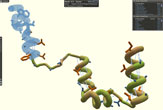Gamers Go Where Computers Can't in Solving a Protein Puzzle

An online game called Foldit is combining the intelligence of thousands of gamers with that of computer processors to solve real-world problems that neither organic nor silicon brains can solve alone.
The game consists of several puzzles – 3-D graphics of protein structures that must be manipulated by players to achieve the correct shape. With each twist or turn of the colorful arms that make up the protein, the player is awarded a score reflecting the “quality” of the fold, or how close the newly formed shape is to what would be expected in nature.
While most of us think of computers as superior to humans in many ways, it turns out that some problems — for example, predicting protein shapes — are better solved with the help of the human brain.
Computers search for the correct shape by making “lots and lots of random movements in quick succession,” said Foldit co-creator Seth Cooper, a graduate student at the University of Washington in Seattle.
Because there are so many possible shapes for proteins, “the chances of the computer happening to randomly stumble upon the right answer is kind of small,” Cooper said. However, people "can kind of look at things and see how they should fit together."
Proteins are molecules that are crucial for life. They serve as the building blocks for everything from hair to fingernails, and help facilitate important chemical reactions that take place inside cells.
Proteins in turn contain smaller building blocks called amino acids. By looking at DNA, scientists can determine the amino acids that make up a protein, but they can't tell how the amino acids interact with one another to create the protein's shape, which is vital for its function.
Sign up for the Live Science daily newsletter now
Get the world’s most fascinating discoveries delivered straight to your inbox.
'Human computing'
This is where Foldit comes in. If the game can lead to better insight about protein folding, it could lead to new ways to fight disease or even allow scientists to design new proteins. [Read " As Video Games Become Ubiquitous, So Do Hand Health Problems."]
“One of the new things that we’re working on is, rather than predicting the structure of proteins that already exist in nature, we’re actually having players design new proteins that … might have new and useful kinds of functions,” Cooper said.
Foldit also could show how humans and computers can work together to solve complex, scientific problems. This cooperative process, sometimes called "human computing," could find uses in other fields and industries.
“There are still a number of problems that we can’t solve computationally or that are extremely difficult or unreliable to solve computationally, but that people happen to be good at,” Cooper said.
Currently, human computing is used mostly for simple image- and text-based problems.
“But Foldit is one of the first examples where we’re taking this important, scientific problem and showing that this, too, can also be solved if you cast it in the right way by all those people out there who are playing video games,” Cooper said.
How to play
The game is open to anyone who wants to play; no technical skills are required. The way it works: Players log into the Foldit website, download the latest protein structure and then start moving the pieces of the 3-D swirls and bundles around, all the while watching their score.
The scoring function reflects certain rules that the hundreds of proteins found in nature seem to follow. One rule is that the hydrophobic or “water-hating” piece of the protein must be buried inside the structure, to protect it from the water in our bodies.
“The person with the highest score potentially has found the structure out of all the players that’s closest to the actual structure that this protein takes in nature,” Cooper said.
The website is similar to other online gaming communities, where high scores are posted and the experienced players help out the newbies. The key difference is that instead of playing the game for the game’s sake, these gamers are helping to solve real-world problems.
Cooper and his colleagues have found that humans, with the help of algorithms provided by the computer, can predict some protein structures that state-of-the-art computational methods couldn't.
The problems that humans were especially good at solving were those requiring some measure of intuition. For example, in some puzzles when the hydrophobic piece was folded into the interior of the protein, the score initially decreases because of some unfavorable interactions between the atoms. At this point, the computer will abandon this line of movement, while humans persist and get back to a better score.
“We haven’t gotten to the point where we’ve cured any diseases or anything like that, but that’s one of the big goals of the project,” Cooper said.
Cooper and his colleagues published their findings in the Aug. 5 issue of the journal Nature.
- 11 Technologies in Danger of Going Extinct
- The Most Influential Video Games of the Last 50 Years
- 9 Super-Cool Uses for Supercomputers











